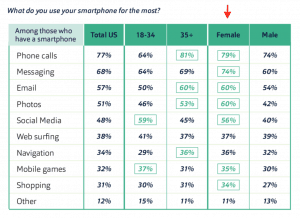Society is changing, and your marketing efforts should too.
Beyoncé wasn’t kidding when she said “We rule the world,” referring to the rise in female mobility, income, and influence. It’s clearly not a coincidence that the number of female Fortune 500 CEOs has increased 2500% since 1995 (PEW) and that we have seen a 20% decrease in the gender gap over the last 50 years (Pay Equality). If current trends project that female consumers and female decision-makers will redefine both the consumer and the business markets, then why are we still marketing to males?
Often, data tells only a portion of the story. As marketers, we often review performance and sales reports that break down traffic, conversions, and revenue according to male vs. female demographics, and we use our findings to influence future marketing efforts. For example, if we are handed a report indicating that male consumers are 2x more likely to buy a product than female consumers are, we focus our marketing efforts on male consumers to improve our ROAS. However, we fail to ask the fundamental question: “Why aren’t more females buying our product?” Due to these omissions, products and brands establish themselves as either ‘male’ or ‘female,’ decreasing their ability to pivot to a different audience in the future.
As we continue to see a societal shift and the rise of the female consumer and female influencer, businesses that structure their brands, products, and marketing efforts towards a male audience may experience low market shares in the near future. On the other hand, businesses that can appeal to the emerging ‘independent’ female consumer and diversify their products will ensure their success over the long term.
This is a not a call for advertisers to start running stereotypical female-oriented ads or to implement taglines like “she’s a Volvo girl,” but rather to understand the newly emerging ‘independent’ female consumer.
The tech industry has historically been a predominantly ‘male-oriented’ market, but Apple has been exceptional in inviting more female audiences to engage with its products. Of course, it has diversified the colors of its products, but—most importantly—the brand has positioned its most well-known offerings, including iPhone, iPad, and MacBook, as ‘social tools.’ As these data provided by Fluent show, females use their mobile devices far more than their male counterparts do, especially for social tasks such as messaging, use of social media, and emailing:

Apple’s deep understanding of its likely future users has allowed the brand to pivot over the last 20 years. Steve Jobs’ commitment to breaking stereotypes of ‘what a computer should look like’ and ‘who should own a computer’ has allowed the company to appeal to female audiences today. Though the company is often criticized for its ‘non-professional’ or ‘non-industrial’ offerings, it’s clear to see that Apple is making a statement about the markets of tomorrow.
Though Apple is a shining star of incorporating female audiences into its plans regarding products and marketing, there are many industries and companies that will need to consider this issue moving forward. Recently, I was looking for a new car, which required me to visit a car dealership. It was a typical medium-size dealership, a large showroom with bright lights displaying a truck, sports car, and minivan.
Let’s imagine if Starbucks, a business that appeals to both male and female audiences, were to design a car dealership. Gone would be the giant super-duty truck, hotrod sports car, and seats-eight minivan from the showroom floor. Instead, the display would likely feature gender-neutral vehicle options focused on design, technology, or efficiency. The environment would be inviting, with attention given to detail, materials, and lighting. Buying a vehicle should be a complete end-to-end experience, no different than purchasing your favorite Frappuccino.
As marketers and business owners, we have a choice: to cater to short-term markets or to participate in the social changes that our world is experiencing today. Our understanding of the newly emerging ‘independent’ female consumer and gender-neutral product offerings and brands are vital to long-term growth and success.

